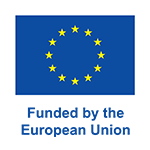TES Cluster
ECHO project is working together with BEST Storage, HYSTORE and ThumbsUp projects as a cluster to support each other in addressing common scientific and technical challenges about technologies for conventional and renewable power generation, enhancing efficiency, flexibility, reducing emissions, and including advanced energy storage solutions.
Building energy efficient systems through short and long spectrum thermal energy storage

Overview
- Three conceptually different modular high volumetric energy density storage concepts will be developed and tested in real conditions allowing to decouple power delivered (charging & discharging) and energy stored.
- None of the storages have heat exchangers inside the vessel where energy is stored.
- Due to the decoupling of power and energy stored, the storage is inherently modular providing cost savings, flexibility in design, size and operation of a storage systems.
- In total, four storage solutions will be developed and tested at different TRL levels, one thermo-chemical material (TCM) storage, two PCM slurry solutions and one sensible water storage with vacuum insolation (VI).
TCM Storage
Long-term Thermo-chemical (TCM) Storage concept in which excess energy from intermittent renewable sources such as PV, solar thermal or wind are stored (see Figure below) to be used later, on coldest winter periods.
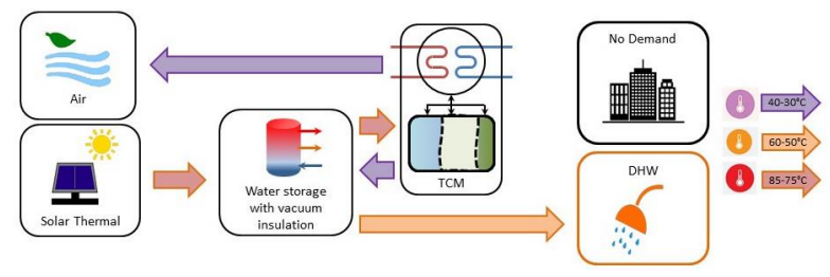
In summer operation (see Figure below left), the thermo-chemical material (TCM) storage can also provide cooling if required. The cold production matches with a discharge of the TCM storage.

Objectives
- Charging of the TCM storage before the heating season will occur either in autumn or, thanks to the integrated buffer tank, during summer nights. In winter, the TCM storage is designed to supply space heating demands for at least 4 weeks.
- Improve heat and mass transfer rate by 50 %
- Reduce the vessel volume by 30 % increasing the energy density by 50% while reducing the storage cost per kWh by 10 % in comparison to current TCM storage design.
Case Studies
- Demo-case in Estonia (Single family home): The TCM as well as the VI-water storages integrated into the building energy management system will be demonstrated for heating and DHW applications bringing the systems to TRL 7
- Demo-case in Greece (Lab-house): The TCM as well as the VI-water storages integrated into the building energy management system will be demonstrated for heating and cooling applications bringing the systems to TRL 7.
- Demo-case in Spain (office building): The slurry PCM-E storage of 9 kWh including the MPC system developed by TEKNIKER, GIROA and AVA will be connected to the production and storage side of the installation operated and maintained by GIROA to bring it to TRL 7.
 Hybrid Services from Advanced Thermal Energy Storage Systems
Hybrid Services from Advanced Thermal Energy Storage Systems
Overview
Develop and validate four innovative sets of Thermal Energy Storage (TES) concepts, based on PCM and TCM solutions.
The four novel concepts attain different applications:
- Heating and cooling
- DHW
- Provision of hybrid services (related to heat and power) thanks to a smart aggregator and an open-source multi-service platform.
Objectives
- Design, manufacture and characterize modular and plug-and-play thermal energy storage solutions for daily to monthly storage with different functions (heating, cooling, DHW).
- Develop and deploy optimised control strategies from TES controller level, aggregation and community-levels for efficient TES operation and energy services provision.
- Provide full integration of the TES solutions with the building heating/cooling system and energy management for grid-aware demand response.
- Validate all technical solutions and ICT tools in 4 representative demonstrators able to simulate different building sizes and usages, in 4 different climates.
- Create an exploitation and capacity building plan for wide scalability and replication of HYSTORE through the engagement of technical and non-technical stakeholders to ensure a long-lasting appeal of the HYSTORE solutions and platforms.
Impacts
HYSTORE will realize the paradigmatic shift of thermal storage from an auxiliary service for HVAC systems to a building service which provides the expected comfort with high efficiency while supporting the grid for effective electric-thermal sector coupling.
Case Studies
Applications will be deployed in for 4 use cases. For each use case a representative business model will be selected.
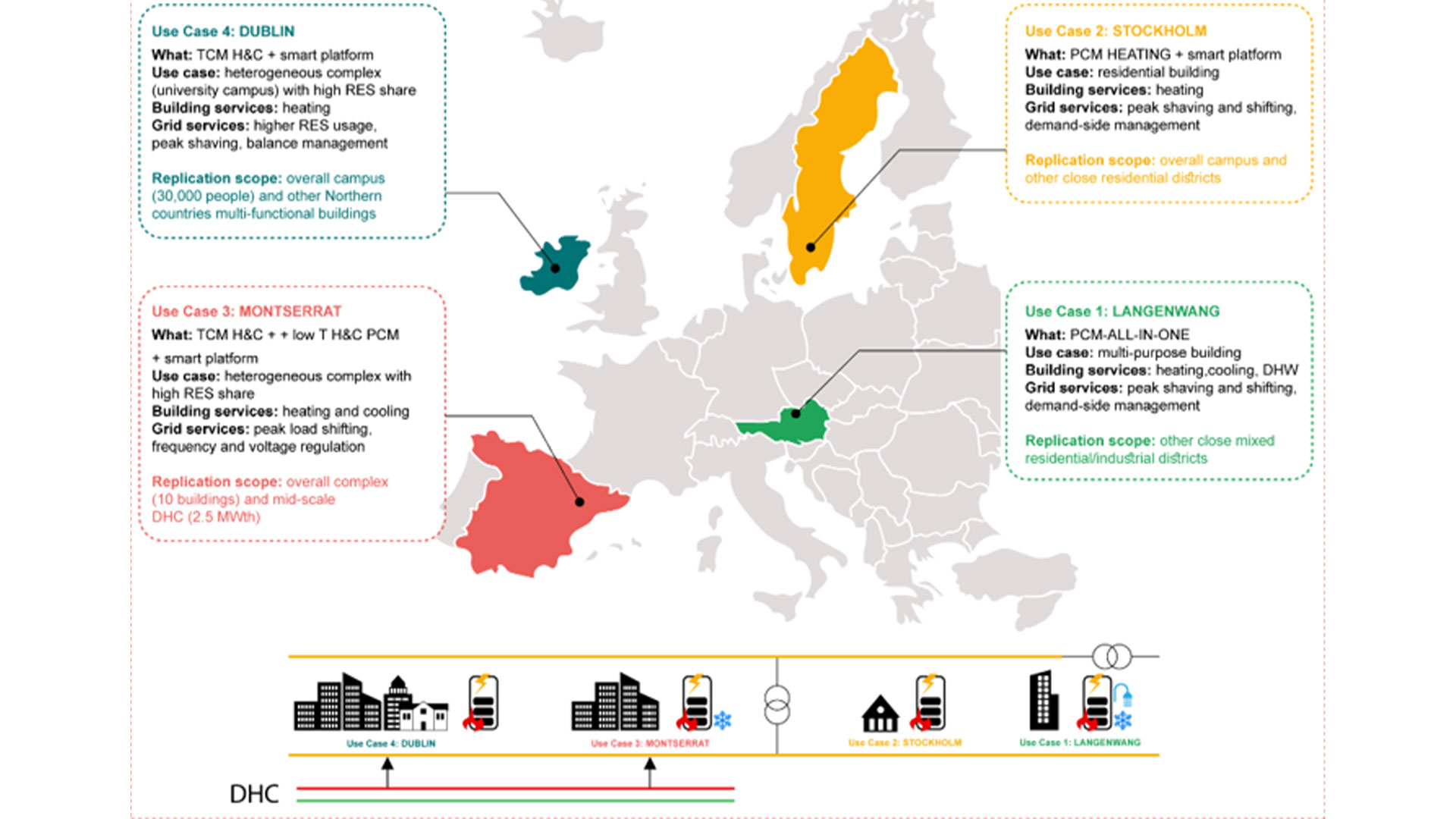
 THermal energy storage solUtions to optimally Manage BuildingS and Unlock their grid balancing and flexibility Potential
THermal energy storage solUtions to optimally Manage BuildingS and Unlock their grid balancing and flexibility Potential
Overview
The ThumbsUp project aims to develop and demonstrate thermal energy storage (TES) at daily (based on PCM) and weekly level (based on TCM sorption technology) solutions to be easily integrate in EU buildings (both connected and not-connected to DHN) to increase their energy efficiency as well as to exploit power-to-heat approaches also to make EU Buildings as grid flexibility actors. The ambition of ThumbsUp is therefore to deeply demonstrate this technology in three demo sites in different EU climates and energy market contexts, also to assess ThumbsUp replication potential in further two replication sites. Via its demonstration and replication campaign, ThumbsUp promotes the role of TES as key enabling technologies to optimise thermal comfort and energy efficiency in buildings as well as to promote Power-to-heat as facilitator of RES grid integration in a sector coupling approach.
Objectives
ThumbsUp aims to overcome the limitations of existing building-integrated technologies demonstrating TES at daily and weekly level solutions to:
• be easily integrate in the different types of EU buildings;
• increase their energy efficiency;
• exploit PtH approaches to make EU buildings as grid flexibility actors.
Impacts
With innovative hase changing and thermo-chemical materials, this European project facilitates the development of innovative, thermal energy storage technologies that can easily be integrated into buildings to increase their energy efficiency and grid flexibility. It aims aims to overcome the limitations of existing building-integrated technologies by increasing energy density and reducing the intensity factors of capital investment in this sector. The project will promote complementary digital innovations aimed at simulating, optimising and maximising the technical, operational and economic benefits of the proposed storage solutions.
Case Studies
TRL6 Validation Campaign (Spain)
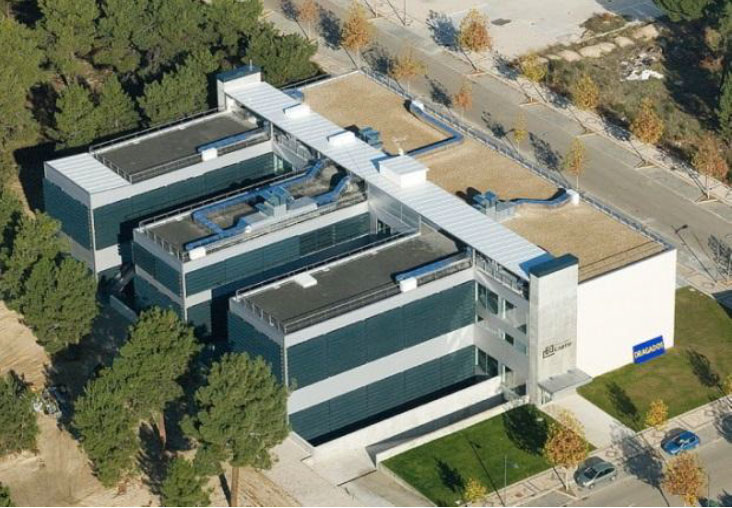
TRL7 Demonstration Campaign (Spain & Sweden)
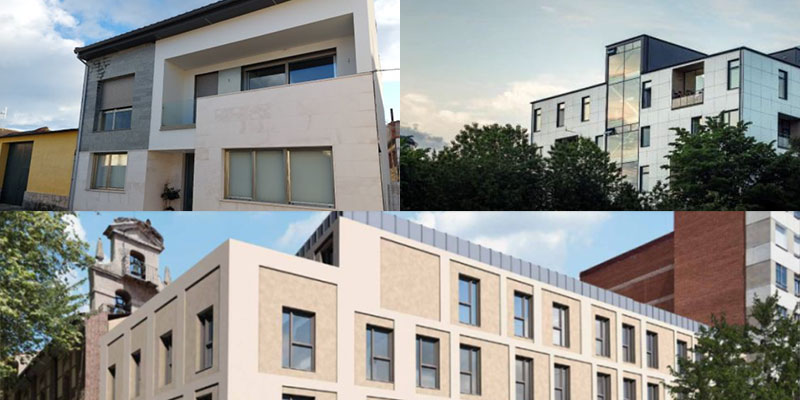
Surefit project

SUREFIT will demonstrate fast-track renovation of existing domestic buildings by integrating innovative, cost-effective, and environmentally conscious prefabricated technologies. This is to reach the target of near zero energy through reducing heat losses through building envelope, and energy consumption by heating, cooling, ventilation, and lighting, while increasing the share of renewable energy in buildings.
This will be achieved:
through a systematic approach involving key stakeholders (building owners/users, manufacturers, product/services developers) in
- space heating
- cooling,
- domestic hot water,
- lighting and
- power generation
- with a demonstration phase in 5 representative buildings in different European climates.
START 1: September 2020
END 31: August 2024
StoRIES project
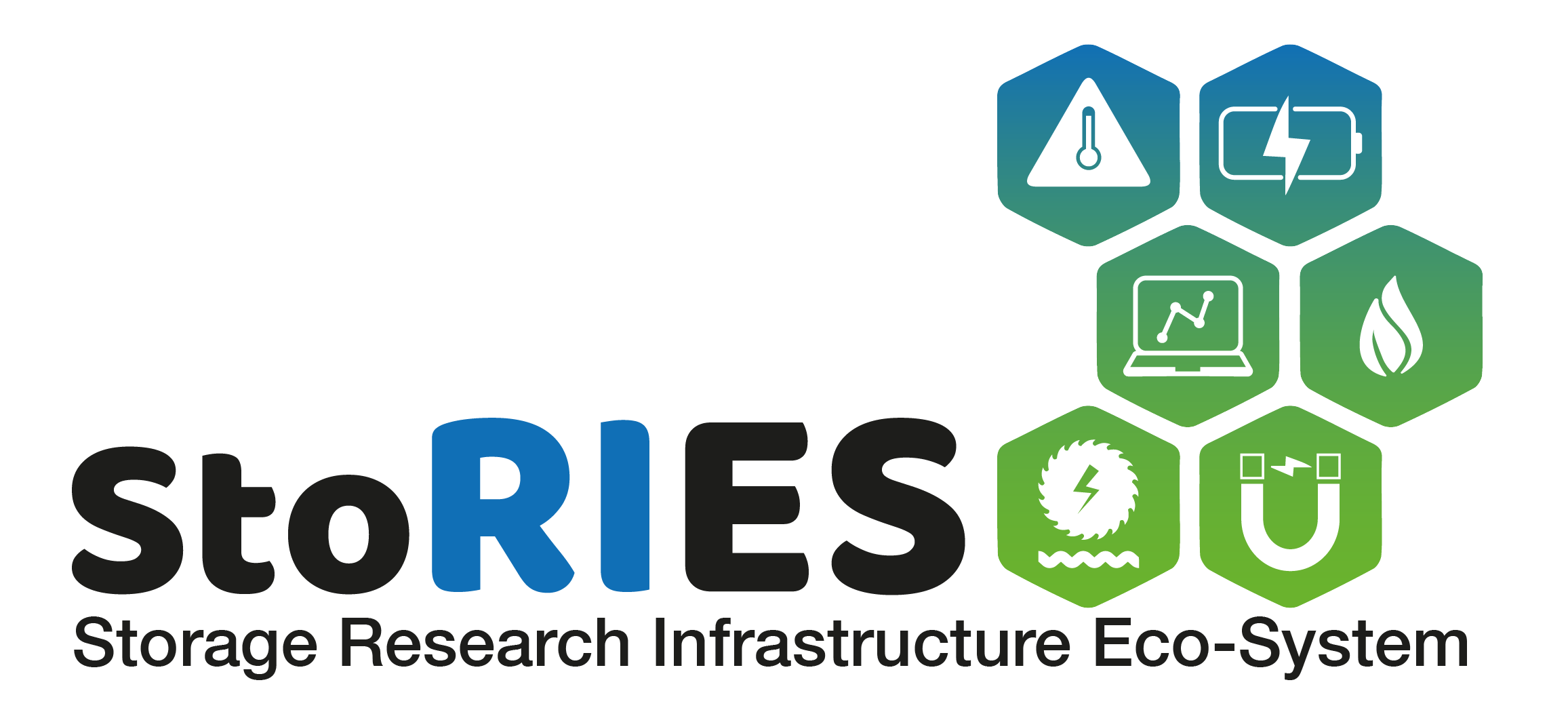
The StoRIES project is born with the idea of addressing this challenge, bringing together a consortium of beneficiaries like facilities from the European Strategy Forum on Research Facilities (ESFRI), technology institutes, universities and industrial partners to jointly improve the economic performance of storage technologies.
The main technological objectives of StoRIES are linked to the energy storage development by providing access to world-class research infrastructures and services, with a focus on improving materials for devices and optimizing hybrid energy systems with a view to make energy technologies more competitive and reducing costs. In addition, StoRIES focuses on the analysis of socio-technical and environmental aspects of new developments and systems, in order to provide training and education on these issues.
START: 1 November 2021
END: 31 October 2025
TES Cluster Newsletter
Newsletter released by BEST-Storage Project!
22 April 2024 We're delighted to share the news [...]



 THermal energy storage solUtions to optimally Manage BuildingS and Unlock their grid balancing and flexibility Potential
THermal energy storage solUtions to optimally Manage BuildingS and Unlock their grid balancing and flexibility Potential

